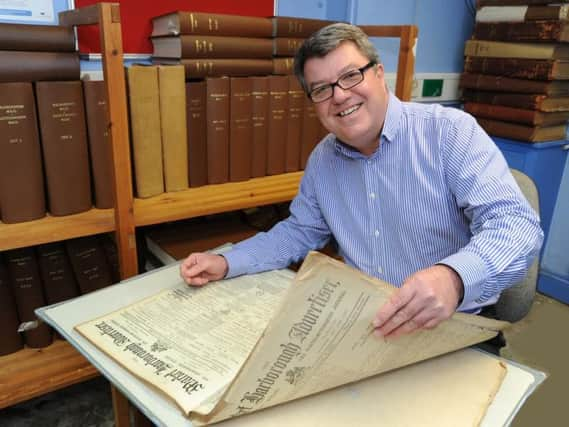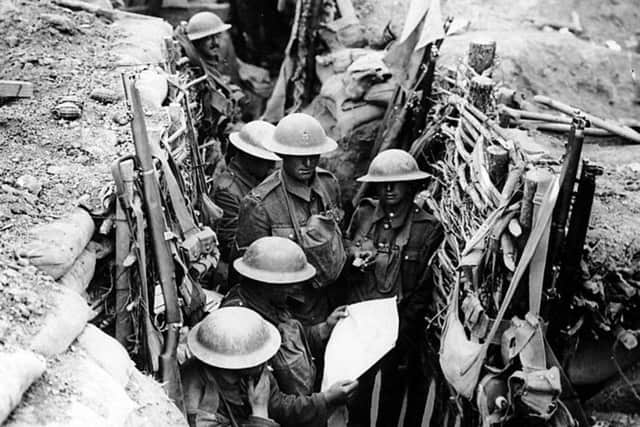John's real-time WW1 blog: Front line soldiers say reading the Advertiser '˜cheers us up'


Readers of the Market Harborough Advertiser were not just confined to Market Harborough and the surrounding villages – the lads in the trenches could not get enough of the paper either.
And in the December 18, 1917, edition of the Market Harborough Advertiser, there is proof with a Letter to the Editor from one soldier complaining about the lack of a memorial service for those who had died in the fighting.
Advertisement
Advertisement
“A few nights ago in my dugout in the trenches I was reading the Advertiser which we always look to and which goes a long way to cheer us up,” says the correspondent, who signs himself An Old Church Schoolboy and Association Change Ringer.


He adds: “I was surprised to read that in my old Parish Church there has been no ringing not even to celebrate our great victory and not even a Memorial Service for our poor Harborough lads who have given their lives for King and Country.”
The Memorial Service controversy has played out in the Advertiser’s columns over the past few weeks and with the hindsight of a hundred years we may be a little suspicious of the anonymous letter: we know the paper was widely read by soldiers at the Front but was this really a letter from a Harborough Tommy or was it made up by the editor who wanted to stir up the debate?
Certainly, the author is in the know when it comes to bell ringing which had almost died out through the war because of two reasons: traditionally, most bell ringers were men and there were not many of them left around and a government curb on bell ringing.
Advertisement
Advertisement
The Defence of the Realm Act had banned bell ringing ‘when requiring lights to be extinguished or obscured is in force the ringing and chiming of bells and the striking of clocks audible in any street or other open space shall be prohibited between the hours between which lights are so required to be extinguished or obscured’.


Other letters from the Front carry more sombre news to individual families, and they, in turn, rely on the Advertiser to tell their community about the injury or death of their loved one.
GUNNER WILLIAM ALLEN of Waterfield Place, Market Harborough, was 25.
Unusually for this period of the war there is a graphic description of how he died. Allen’s company major says in a letter to the family: “Your son was killed in action through an enemy shell directly hitting a dugout in which he and four companions were and crushing it. Your son and three others were killed and the fifth occupant was severely wounded. Your son literally died at his post as he was on duty at the gun position at the time.” He adds: “It may comfort you to know that your son did not suffer as he was rendered unconscious from the outset and died almost immediately. He was wounded in the head and the side and was taken immediately to the nearest
Advertisement
Advertisement
hospital but had succumbed to his injuries before reaching it.”
CORPORAL J R SOARS was the brother of Mr J W Soars, a dentist of High Street, Market Harborough. In a letter to the family, a chaplain explains that Soars had initially been injured but died in a clearing station and was buried in an English cemetery.
PRIVATE GEORGE SPINK of Coventry Road, Market Harborough, was in the front line with the Suffolks Regiment when he was instantaneously killed by a shell. He leaves a widow.
PRIVATE W MARSHALL Only 19, Marshall used to work at Messrs R and W H Symington factory before joining up at the beginning of the year. He is the youngest of five brothers, two of whom have been wounded. He was in the Machine Gun Corps and in a letter to the family his company officer says: “He was one the best men in the section, always cheerful and a good worker. He was killed by a shell which landed right on the dugout where he was. Death was instantaneous and he could have suffered no pain.”
Advertisement
Advertisement
Brief details are also given in this edition of five Harborough men who have been injured: Acting Corporal F Sumpter, Private H C Russell, Private W Reedman, Sapper A E Payne, Private H Green, and Gunner H Church.
And finally...there is news of a battle field much closer to home than the fighting in France and Flanders. The field, which was the site of the Battle of Bosworth in 1485 when Henry Tudor overcame Richard III to end the War of the Roses, has been sold to a ‘Leicester syndicate’.
The field, which is just a part of the sale of the Market Bosworth estate of the late Lady Agnes Scott, was ‘where Richard was slain and the Earl of Edmund [Henry] was crowned’.
The story also notes that the estate includes a well ‘from which King Richard is alleged to have quenched his thirst...and is of much interest with many Americans having visited it’.
Advertisement
Advertisement
- This column is published every Monday by John Dilley on the Newspapers and the Great War website and will continue until the 100th anniversary of the final armistice in November 2018.
- My fellow researcher and De Montfort University lecturer David Penman is conducting a similar real-time project with the Ashbourne Telegraph. Check out his Great War Reports.
- Check out this week’s Harborough Mail for current news from the Market Harborough area.